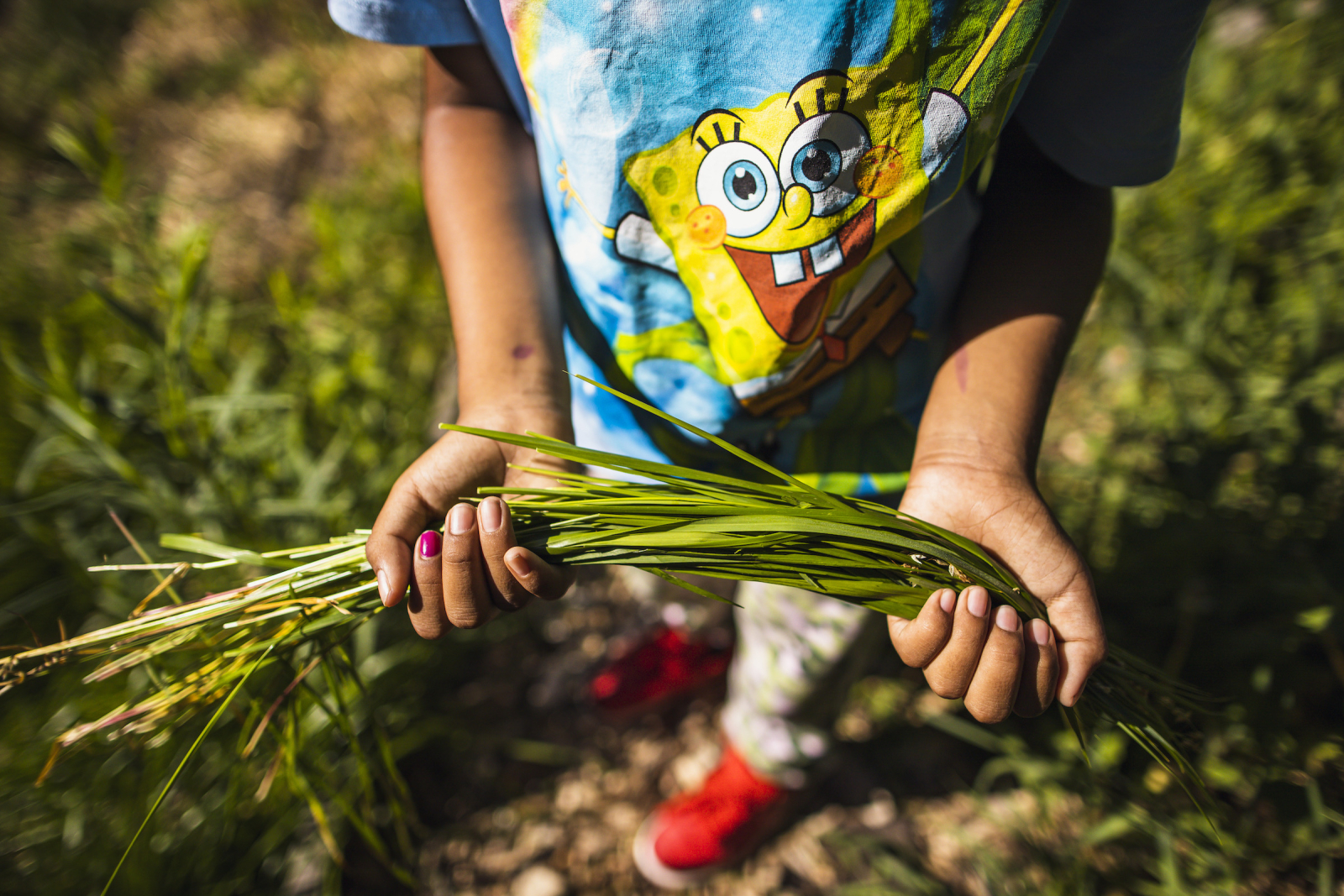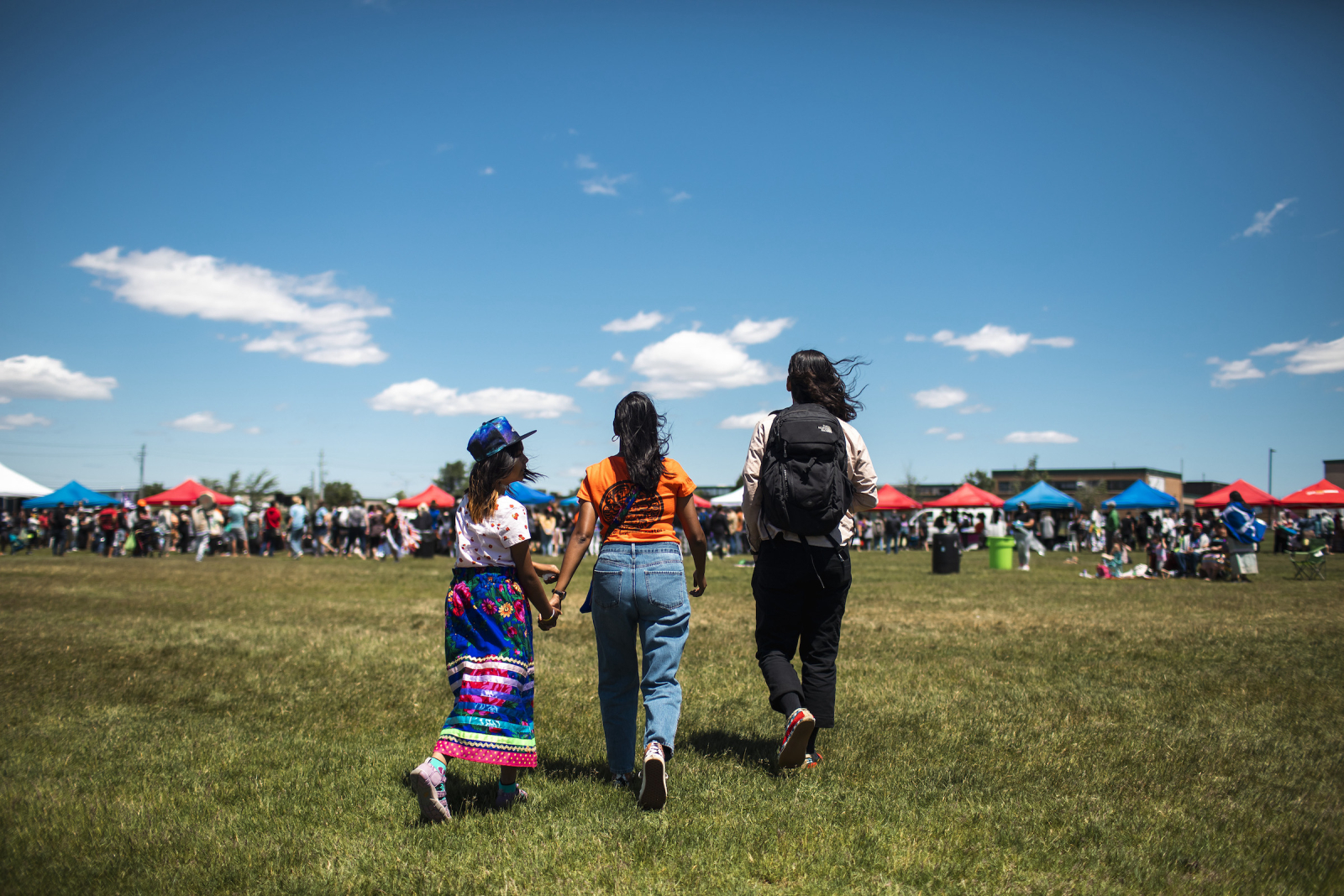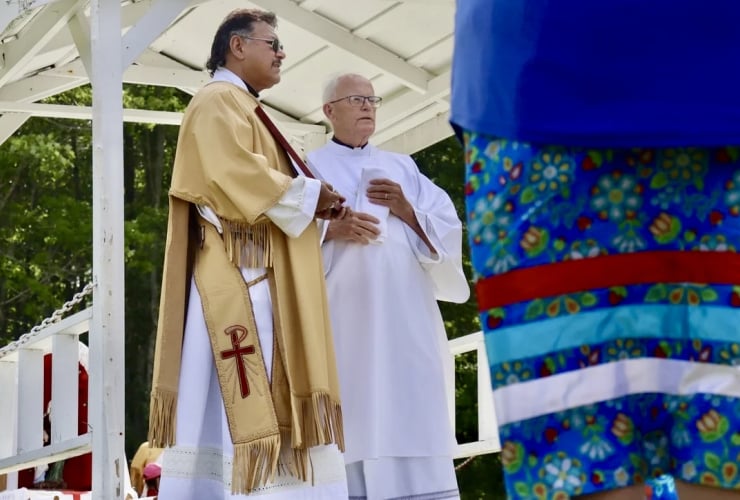My niece Z, her mom Ashley and I watched from our Walmart camping chairs as the tiny tots, dressed in their tiny regalia, toddled around the dance circle chaperoned by moms, dads, aunties and uncles. It was Pride Month in Toronto, and for the day, the Two-Spirited People of the First Nations Powwow had reclaimed a patch of grass from the former Canadian Forces Base in Downsview Park. Seated around a drum on the far side of the dance arbour, the singers struck the hide and belted out a Nickelodeon-inspired tune, calling all the pint-sized Indians into the circle. I’ve heard many powwow songs in my time, but never this one.
Way-way-ya way-ya way-ha
Way-way-ya way-ya way-ha
Way-way-ya way-ya way-ho
Way-way-ya way-ya way-ho
Way-ho
Way-ho
Way-ha
Way-ha
Way-ho way-ha way-ha
Way-ho!
Who lives in a pineapple?
Who lives in a pineapple?
Underneath the blue sea?
Underneath the blue sea?
Sponge Bob
Sponge Bob!
Square Pants
Square Pants!
Sponge Bob Square Pants Sponge Bob
Square Pants!
Powwows are Native celebrations of culture and community. And for some, like a younger me, they’re kind of like rodeo — a competitive, continent-wide circuit travelled by singers and dancers from all across Indian Country. These competition powwows — the dominant type of powwow — are, as a rule, organized by categories of gender, age and dance style. Each women’s or men’s style has its own unique footwork, songs and regalia. And these are strictly observed. In competition, a woman must know all the songs and steps and wear an outfit appropriate for her dance. The same for men. Not to do so would be disqualifying and, in some instances, inappropriate. At many powwows, when women dance a man’s style or men a woman’s, it is for a special, entertainment-oriented contest with a clownish feel called “switch dance.”
Just this summer, Kamloopa, the largest powwow in British Columbia, published contest rules stating dancers must be dressed in the category “appropriate for their gender.” The phrase fomented outrage on social media, and organizers quickly apologized — a sign of changing times and attitudes. It was just 10 years ago that the first two-spirit powwow to celebrate the essential role played by genderqueer people in many Indigenous cultures and cosmologies was held in San Francisco. The Two-Spirited People of the First Nations Powwow in Downsview Park, held the first weekend of Pride Month, was the first two-spirit powwow in Toronto.

Z wants her own regalia so she can dance: maybe fancy shawl, traditionally a woman’s style, or hoop, one of the only styles danced by all genders. And though she’s just nine years old, Z is starting to figure out who she is as a Native person growing up in a non-Native household and as a pre-teen exploring gender and sexual identity.
You see, Z has never been home to Canim Lake, an Indian reserve in British Columbia’s rugged Cariboo that’s home to about 250 Natives, almost half of them our relatives. Of the many sons of Canim Lake, I’m the only one whose trail meanders through Toronto from time to time. Though I am Z’s first cousin once removed by blood, our relationship, combined with my age, means that Z calls me “uncle” — a role I’m new to and take very seriously.
Because like Z, I grew up in a home with a non-Native mom. My Native dad wasn’t in the picture. And, like Z, I was scared to step into the dance circle and our culture. I owe a lot to the uncles — some by blood, but many not — who helped me understand my identity as an Indigenous man. As Z’s uncle, I feel like it’s my turn to pay that forward.

Earlier that morning, I braided Z’s hair while she watched her favourite show: Sponge Bob Square Pants, of course. Her mom packed up her new ribbon skirt, a dress worn by Native femmes at cultural gatherings like powwows — a gift from my mom. Z undid the braids in the car. When we got to Downsview Park, the ribbon skirt remained stubbornly folded in her mom’s tote bag. The Polaroid Z borrowed to document the day hung limp from her wrist. Before settling into her folding chair, a customary powwow ware, Z turned down frybread and corn soup from the Indian taco stand.
As the tiny tots showed us their best moves, I glanced over at Z, my gaze conveying my hope that someday soon she would be gliding, spinning and sliding with pride in that circle. Evading eyes and expectations, Z grabbed a blue surgical mask and plunged her face into its baggy recesses.
After tiny tots, the powwow organizers took a break from the traditional proceedings for a pop-up drag show in front of the announcer booth. A crowd gathered round. Peering over and around onlookers’ shoulders, the three of us watched Indian queens, aunties and uncles strut, pirouette and vogue in front of the eagle staffs and rainbow flags. It was an atypical powwow experience, to be sure, but one that hopefully, with the growing acceptance of two-spirit powwows and two-spiritedness, will become more common.
I was captivated. Actually, more than captivated. I was into it — ready to be that one uncle stuffing colourful bills into brassieres. As she’s started to sort out who she is and how she identifies as an Indigenous person, Z has also been asking questions about two-spiritedness: what it means, who embodies it and why Native people celebrate those roles. And yet, today, Z seemed about as interested in drag as she was in her ribbon skirt, frybread and powwow dancing. We hadn’t heard a single Dolly Parton anthem before Z opted for the bouncy castle.

Getting Z out onto the dance floor and into the urban patchwork of Indigenous cultures that exist in a place like Toronto — three time zones, thousands of kilometres and a world away from the river-cut plateaus and alpine valleys of our Secwepemc and St’at’imc homelands — would be no walk in the park. I remember how scary it was to step into my identity and wonder whether I would be seen and accepted for it — and, at the end of the day, I’m a straight dude. But as the cadavers of hundreds and then thousands of Native kids, many Z’s age, some even younger, have been discovered at Indian residential schools across Canada, something as simple as a traditional dance feels, to me, like an act of survival.
All of Z’s paternal great-grandparents were taken away to residential schools on cattle trucks when they were even younger than she. At the Kamloops Indian Residential School, where Z’s great-grandmother was sent, researchers have identified 215 potential unmarked burials of children. At St. Joseph’s Mission in Williams Lake, B.C., where Z’s other great-grandmother was taken, researchers have identified 93. Canada’s Truth and Reconciliation Commission has described the Indian residential school system as an act of “cultural genocide.” With each grisly discovery, it looks like that modifier, “cultural,” is too narrow.
I’m new at uncle-ing, but as I understand it, if you can’t get a kid to pick up a sport, find a hobby or play an instrument after a few tries, you let the thing go. But this particular thing — culture, identity, pride — doesn’t feel like an Uncle Mission one should give up on. So, I changed tack.
During the next round of intertribal social dances, open to everyone regardless of regalia, I took to the circle in my red moccasins. They’re beaded with colourful portraits. On the right foot: me. On the left: my late best friend, Ivan. Though I am heterosexual, things happen when you’re young. And in all my 29 years, Ivan is the only boy with whom I have ever shared a physically intimate moment. I really loved him.

The same year I graduated from college, Ivan’s heart, inflamed from heroin use, gave out. One year later, on the streets of Winnipeg, Z’s biological father Dakota, my closest-in-age cousin, overdosed on fentanyl. I had lost touch with Ivan when I headed off to university in New York. I did not even know he was an addict. And I hadn’t talked to Dakota since we were 12- or 13-year-olds, dragging each other around the Canim Lake rez on sleds, digging into whatever boyhood trouble could be unearthed in his father’s, my uncle Gregg, trailer.
As I look at my niece, I inevitably think about Dakota, Ivan and loss. Yes, there is death, but there are also the connections that time, addiction and life fray. I feel guilty for all those struggles that I did not know, and for all those moments I was not there.
But the day of the powwow, I was there: a green uncle Indian dancing in my guilty red moccasins, each step calling my niece into the circle. Chest out, shoulders back, knees bouncing waist high, I made my way around and around: one, two, three, four songs — all of them alone. Men’s traditional, the style I predominantly danced the summers I travelled thousands of miles on the powwow trail, is a dance for the hunt and warpath. The dancer’s movements convey the strength of their spirit and story. Sometimes, the story is about sneaking up on the enemy. Sometimes, it’s about stealing horses, or crows hopping through the carnage after a battle. And sometimes it’s about a niece who won’t budge from her chair, no matter what her mom or uncle do.

And as I circled the arena, Z’s mom, the resilient thread tying Z to me and her Native family, was losing patience. On the hunt for a proud, dancing niece, I made one last revolution, this one a double beat style crow hop, while mom levelled with daughter.
“It would mean a lot if you went out and danced with Uncle Julian,” she said. “Or even just walked.” Z rose reluctantly from her perch and donned her ribbon skirt. Head down, she dragged her feet beside mine.
When Z’s first song ended, the emcee called for a round dance, a social dance open to everyone. The arena filled with dancers and spectators of all ages. Z held my right hand in her left as a brown woman, dark like Z but with dreadlocks, reached out and grasped her right. Palm to palm, we swung and swayed the Indian way clockwise around the circle. Every so often, one of the head dancers would lead all 100 or so of us in a giggling charge to the centre.
The song ended and the dreadlocked woman bent down to look Z in the eye. “Good job!” she said. And for a moment, Z, who has a hard time with crowds and smiles, tried on a wide grin.

I watched my niece’s metamorphosis with wonder the rest of the afternoon. After the round dance, she picked up her Polaroid to snap pictures of the hoop dancers in action. Her teacher from last school year, Mr. Rhimer, who clearly cares, showed up. Z walked the powwow vendor booths with him and her mom. She found a beaded burgundy, orange and lime green medallion — eclectic and different, like her. Her mom gave her the cash to buy it. Then, she ran into a few of the people she knows from Toronto’s urban Native community, including Ethan Lannigan, a Metís from the Red River Settlement who co-leads an urban Indigenous gardening collective. Shaded under a canopy, Lannigan sat cross-legged beside Chris Merkel, a West Coast Native born in Ontario, like Z. Chris’ Tahltan relatives fish the Stikine River in northern British Columbia and the Yukon pretty much the same way our Secwepemc and St’at’imc family fish the Fraser.

“You do enough laps at the powwow, and you’ll find people from your territory,” Lannigan counselled Z. You do enough laps at the powwow and I think that maybe, just maybe, you’ll find yourself.
Z was getting hungry. Her mom went for Indian tacos while my niece and I watched the chairs. While they were gone, a raffle for dancers without regalia was called.
“I’d like to dance,” she’d been explaining to me, “if I had regalia.”
“Now’s your chance, Z!” I said. “If you get out there, one of these days, I think a powwow outfit might just come your way.”
Z rose from her folding chair again, this time with more confidence, and though she had no shawl to drape across her shoulders, when the drummers kicked off a real jamming song, Z gave it her best fancy shawl, kicking up those legs, making uncle proud.
Hey-hi-ya
Ya-hey-yo
Hey-hi-ya
Ya-hey-yo
Hey-hi-ya
Hey-hi-ya
Hey-hi-ya-ho-ya
Hey-hi-ya-ho hey-yo
Hey-ya-hey-yo
Z didn’t win the regalia. But by the time the powwow organizers were calling out the lucky numbers, Z, Ashley and I were lounging circle-side in the grass with our Popsicle-stained lips curled towards the sky and the weight of our sun-drenched bodies sinking into our shoulders. Our courage had been tested. Z’s Polaroid was spent. And according to the traditional observance of powwow etiquette, it was time to dance out the eagle staffs and rainbow flags.
In the powwow circle, a dancer’s initiation is referred to as their “coming out.” In a coming out ceremony, a dancer’s family puts on a big giveaway for the powwow community and dances the initiate into the circle. In return, the community accepts the dancer as one of their own. The LGBTQ2S+ community uses the same phrase to describe disclosure of gender and sexual orientation. Both hinge on the participation of family and community, the initiative of the individual who is “coming out” and on the willingness of the circle gathered around them to witness, accept, support and embrace. In dancing, as in life, Z’s still working through her multifaceted identity. For all of it and for as long as it takes, uncle is here.

a great read julian... thank
a great read julian... thank you so very much...
i wish z all the best on her journey...






Comments